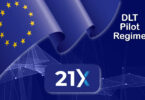Monax announced that eleven organizations are partnering with the Agreements Network (AN) which turns ‘legal processes into products’. The network enables people to create legally compliant agreements from templates with a few clicks.
The project deserves attention because of the involvement of Monax which is known for contributing the code to Hyperledger Burrow.
The AN announced it’s working with law firms BakerHostetler, LegalBono and ErdosIP. Additionally, tech firm partners include Clause, Crowdcube, LexPredict, Libra, Mattereum, Monax, Rymedi, TransparentNode and Wolfram Blockchain Labs.
The business case
Using lawyers is expensive, and they often provide clients with tweaked templates. Some existing internet sites offer template contracts, but there’s not a good selection.
Looking to the future, the combination of blockchain and AI will mean more and more business processes are automated. As the speed of business accelerates there won’t be time to wait for lawyers. Automated business needs automated agreements.
By creating a decentralized network, the AN adds several features. It creates a marketplace where many lawyers can offer their templates, and receive compensation.
The network could even reduce litigation over contracts. It’s much harder to dispute a deal when there’s third party proof of the existence of the contract. Plus as the agreement evolves, there’s proof of the changes.
It’s great when a contract endures for many years. The trouble is finding the hard copy after five or ten years. The AN stores the contract in a confidential manner.
Perhaps most valuable of all is the ability of the contract to be dynamic rather than static. A legal contract can even potentially interact with other legal contracts. But it’s much easier to appreciate the benefits with an example.
How the Agreement Network works
The AN uses the term Archetypes to refer to template agreements for specific things. eg. a generic shareholder agreement or a software development agreement.
‘Archetype factories’ allow you to personalize the templates by adding names, amounts, dates and the like. But you can’t add and remove new paragraphs or clauses. And once you’re finished, it produces an ‘Active Agreement’.
Active doesn’t just mean the agreement is live, it’s also dynamic. In the blockchain world, an agreement can adapt. AN’s ‘workflows’ deal with this logic or business process.
For example, in a software development agreement, the agreement price might be $10,000 based on certain specifications. There could be a performance bonus of 5% if the software is delivered by an early deadline. And a penalty of 5% if it has passed a later deadline.
In the AN, the process steps include the developer updating the project’s progress, and the client confirming. The process engine then triggers a payment on completion. The payment calculation compares the completion date to the early and late delivery deadlines and adjusts the agreement price accordingly.
If the payment uses Ether, AN will talk to Ethereum. But it will also be able to trigger invoices on QuickBooks or Xero.
Bite-size contract pieces
In software development, it’s common for clients to expand the requirements as the project progresses. It’s a painful process that involves a lot of emailing back and forth. But if the contract is on AN, one could add a software feature and associated price, and both parties share the updated agreement.
If one of the parties is less trustworthy than you’d like, having the agreement on a blockchain makes it far harder for someone to say ‘I never agreed to that’.
Casey Kuhlman, CEO of Monax elaborated: “The other piece is that breaking a contract down into bite-size pieces of evidence helps reduce incentives to lie. So with the AN the real value for business users is knowing (a) what was agreed; (b) what are the bite size pieces of things that have happened along the way; and (c) what is the difference between those two. This gets to the idea we call ‘transactional execution risk'”.
Use cases
The AN outlines three example use cases, equipment fleet leasing, content licensing and corporate governance. The leasing one is perhaps the most interesting because you can see how a new drone or piece of equipment could automatically be added to an agreement.
There’s also some demand for this sort of solution by enterprises today. Take Deutsche Bahn the German railway company. It has 760 different companies in the group, and they have agreements with each other. They’ve already built a system to manage the contracting process with plans to use it for supplier agreements. But enterprises may not be so keen that the Agreements network is public.
Public Permissioned
The majority of blockchain networks are either public permissionless or private permissioned. The AN is really a public network, with one aspect permissioned and that’s the lawyers. That way they can make sure that actual lawyers produce template contracts.
Technology and confidentiality
Unsurprisingly, the AN will use Hyperledger Burrow which implements the Ethereum Virtual Machine for permissioned networks. As the system will be a marketplace, it will also use public Ethereum for transacting payments with alternative payment options. The two networks will talk to each other via Cosmos which should launch soon.
One of the most significant questions should be confidentiality. Kuhlman described the approach as keeping the main content of the agreement encrypted outside of the blockchain with restricted access. “In general how we approach this is by moving the most important piece of confidentiality (the prose template and the parameters — which is where, for example how many widgets were ordered or the price that they were ordered in) into a system called Hoard.”
“Hoard allows for envelope encryption to be applied to off chain content and also allows for content addressability. This is similar to how many folks in the blockchain space deal with IPFS snippets for off chain data, however Hoard enables content addressability for files that may not be widely shared and are only available to the parties themselves.”
Who else is active in the space
There’s already quite a bit of activity in the legal sector. The highest profile is the Accord project of which Monax is a member.
Startup Clause is a contributor to the Agreements Network and founded Accord. They responded: “The Agreements Network will support the Accord Project’s open source technology and standards for modeling and executing smart legal contracts. The [Accord] Project provides an industry standard for open source smart legal contracts.” More than forty legal firms support Accord.
“Clause, a contributor to the Agreements Network, founded the Accord Project in 2017 and will be supported as a default contract lifecycle management provider for the Agreements Network.”
There’s a competitor network called Open Law which comes under the Consensys umbrella.
Market impact
Apart from project information published by Monax, what’s the impact on contracts going forward? There’s the potential for matching automated business with automated agreements, but there are some more immediate benefits.
Imagine you’re an end user that wants to create a developer contract, and the network offers fifty to choose from in your jurisdiction. No doubt there will be some sort of rating system where users vote. For clients, agreements worded in plain English might rank well.
Never mind the automation, moving agreements en masse to plain English could be a big win.






